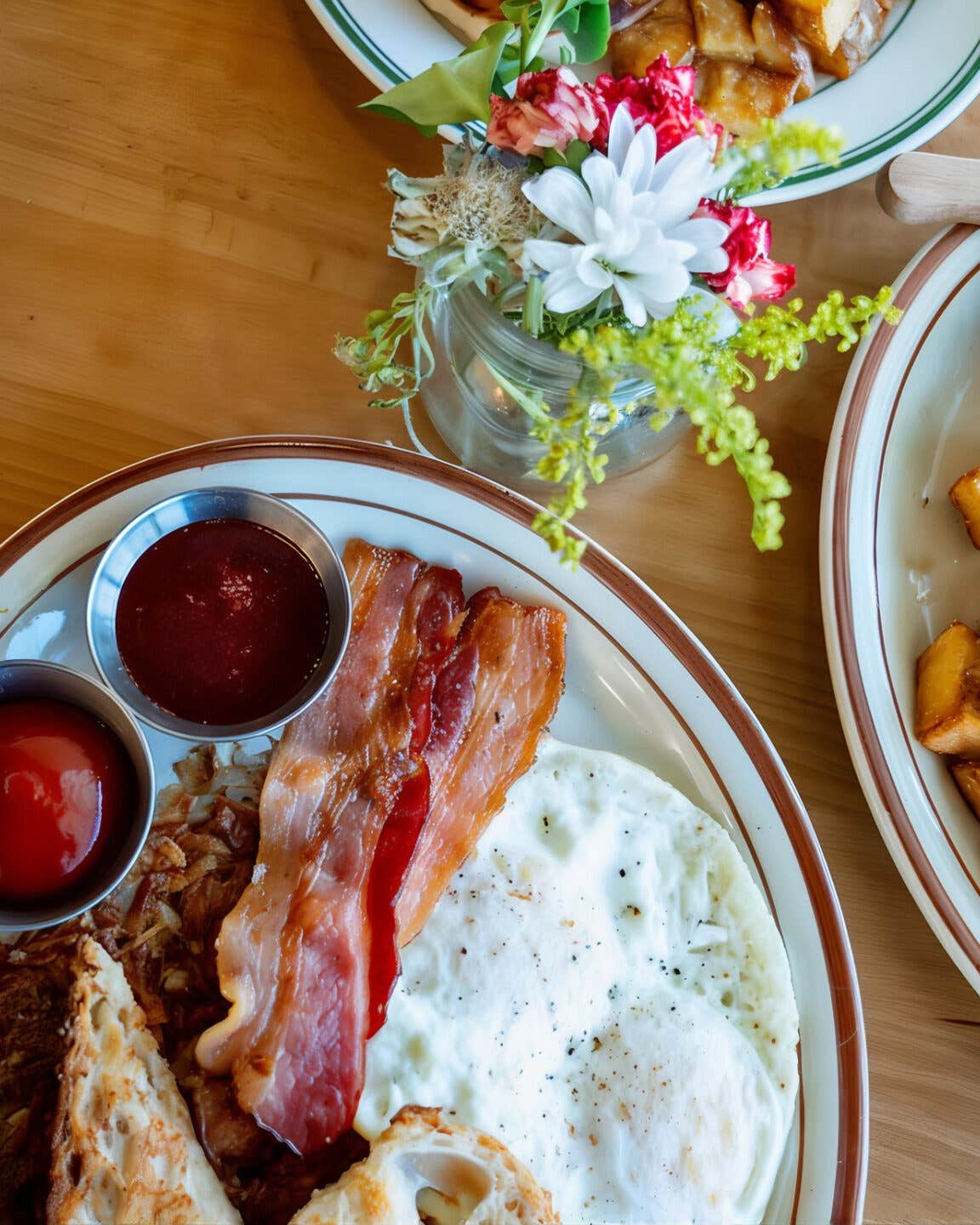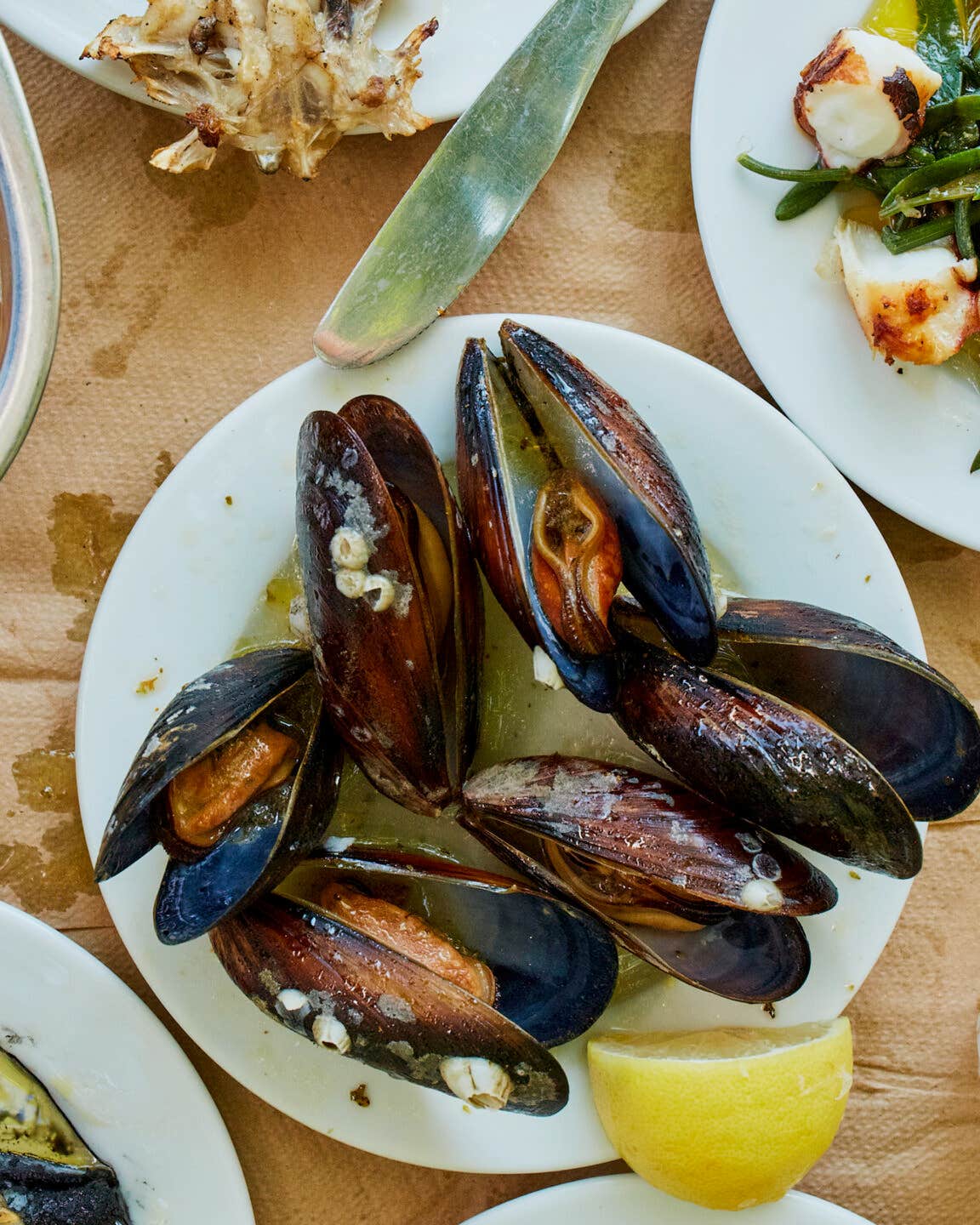
State Fair
Echo and Erica, though goats, had a certain stylish insouciance. They spent their days in our Iowa City backyard, snacking on organic alfalfa and freshly milled goat granola. In the mornings, despite my determined efforts, they contributed no more than a modest splash of milk, and they steadfastly declined to improve their contrary comportment. Afternoons, the pair would step out of their shed, strike a distracted pose, and bellow, causing one neighbor to file suit and another to attempt to assassinate Erica. Not the sort of 4-H project to make it to the big time. So it wasn't until last summer (long past my girlish goat days) that I finally got to the Iowa State Fair, with its neon swirl of carny rides, its snappy tractors, and its corn dog overload, all under the beatific gaze of the Butter Cow.
The first Iowa State Fair, in 1854, scandalized thousands with women's horseback riding. Since then the event has gotten bigger—nearly 950,000 people milled around the massive fairgrounds, on the east side of Des Moines, last summer—and only a little snazzier. At the Iowa State Fair, you can watch toddlers in tutus shake their rumps to "Sugar, Sugar". You can lounge under a cloud of exhaust while guys in jumpsuits drive circles in the dirt. But all that, I soon learned, would be missing the point. The Iowa State Fair is not about entertainment. It's about competition. Here, once a year, just as crunch time in the agribiz ends, farmers dust off their feed caps, housewives close up their kitchens, salesmen flick on the call-forwarding, and they all head for the fairgrounds—where, in the name of fun, they do precisely what they did at home: Farmers compare crops, housewives compare jellies, business guys hawk cellular phones. The difference is that here, anyone can vie for a ribbon.
I get my first taste of the Fair at night, parking in a rutted field. As I walk toward the gates, I can see the double-barreled Ferris wheel arc across the sky through the steamy dark. Inside, I follow throngs of fairgoers (74,239 that day) roving the grounds in bleary, cheery hordes. At this hour, the Fair is carnival, festival, and feast. Grown-ups walk by clutching steins of beer and the bulky, two-handed, foil-wrapped sandwich extravaganzas called Gizmos and grinders. Kids lug turkey legs like massive meaty ice cream cones. Smoked off-site and crisped on grills all over the fairgrounds, the legs offer portability, a good pound of gnawing, and a certain retro appeal. "Like a caveman," says concessionaire Debbie Hardenbrook, as someone passes by holding one. (While she credits beef- and pork-shy health nuts for the booming turkey business, smoking insures that the legs taste an awful lot like Iowa's favorite dish: ham.) Debbie's fair-food lineage dates back to 1913, when her grandmother ran a dining hall in the Cattle Barn. "People don't go for full meals any more," she says. "They want something to grab and keep walking with."
Back in 1946, fresh out of the service, Carl Cardamon and a buddy set up a Carl & Ted's Dining Hall, offering Swiss steak, chicken and noodles, fish, and meat loaf—all at once, every meal. Today Carl hawks the Gizmo sandwich—a glorified sloppy Joe, similar to the tactlessly named Jennie's Original Guinea Grinder, the competing sandwich that has, for the past 24 years, been served about six feet away. "If you're sure of yourself and sure of your sandwich," sniffs Jennie's daughter, JoAnne Sample, "there's no competition."
Revelers on the fairgrounds cruise a kind of make-believe town that hasn't changed much since Phil Stong's 1932 novel _State Fair _(on which a musical and three movies have been based). Prize hogs fill the pungent Swine Barn; the pink-nosed Largest Horse ignores gapers outside the Horse Barn; row after row of shucked corn primps in the Agriculture Building. While the permanent architecture—graceful turn-of-the-century brick pavilions—is under landmark protection, the temporary structures have their own distinct style: Each plain white box food stand pops open, sprouting a neon pagoda here, a wooden clog there, and each posts a charmingly concise menu to match. At Florrie's Funnel Cakes, for instance, hungry fairgoers have a choice of "Funnel Cakes. Soft drinks. Coffee." Funnel cakes, a kind of fried dough with Pennsylvania Dutch roots, are made with a more free-spirited exuberance than their tidy doughnut cousins. A stream of sweet eggy batter plummets into the deep fryer in a wild tangle, guided only by a funnel and the whim of a teenage chef. "You make designs in it," explains lifelong funnel-cake expert Jada Blewer, 18. "Sometimes you'll put your initials in it."
But funnel cakes, Gizmos, and grinders are merely convenience foods. For 11 days of horseshoe-pitching, hog-calling, and tractor-pulling, you need a portable feast. This is where the Fair's most distinctive culinary contribution, the Stick, comes in: At the Iowa State Fair, you can have ice cream (dipped in chocolate, then nuts) on a stick. Pretzels on a stick. Caramel apples on a stick. Cheese, turkey, chicken, sausage, or bologna on a stick. Pickles on a stick. The Fair's true gastronomic claim to fame, though, is the corn dog—a dough-dipped crisp-fried hot dog on a stick. "The stick thing is just easiest," says corn dog heiress Helen Little, whose father, Melvin P. Little, brought the corn dog to the Iowa State Fair in 1956. As a teenager, Helen was pressed into shouting out its theme song: "Get your educated pronto pup! Rides a stick, swims in grease, and wears an overcoat. You bite it, it won't bite you!" (Barking is frowned upon at today's cleaned-up Fair.) The corn dog has become the very symbol of the Fair's pork-centered, corn-crusted, deep-fried soul. "Corn dog," says longtime fairgoer Arlene Eckhart, "is the Fair." Arlene comes here every year with her mother and three sisters. "We start eating when we get inside the gate, and we eat all the way through." Their matching T-shirts proclaim, "Breakfast, lunch, and dinner." With their bright red lipstick, black shorts, and bobby socks, they suggest some food-themed girl group.
Iowa is home to 2.8 million citizens and 24 million hogs. So it's no surprise that the biggest crowd at the Fair is bunched up at the the Iowa Pork Producers Association tent. "Even though you may be 100 miles from home," reads a placard, "you're only 10 minutes from a delicious pork dinner." The wait is eased by 19-year-old Tammy Halbur, Iowa Pork Queen, who, in her pigskin sash and delicate tiara, perkily totes up orders for ribs and tenderloins. The line files past massive outdoor grills, where hefty pork producers baste and turn 90 Iowa chops at a time. A sign urges me not to miss the farrowing display in the Swine Barn. There, I find Stephanie Brown, 15, seated in an otherwise unoccupied stall, trading jokes with her mom and a friend. I don't know a lot of teenagers who'd look forward to a night with Mom in the hog pen. But Stephanie assures me that she's having the time of her life. Over in the Sheep Barn, Ryan Mortvedt, 14, is tending four shy sheep; two sport khaki jackets, one's wearing a blue scuba suit. Sheep are Ryan's favorite animals, and he explains that the cover-ups keep them pristine (and presumably protected from a whiff of the future: Outside, the Iowa Sheep Industry Association trailer is serving up grilled lamb burgers and lamb sandwiches). I try to chat with Ryan about concerts and roller coasters, but he gives me a blank look. In a lifetime of summers, he's never bothered with the midway. The Fair, for him, is showing sheep.
That's when I realize that the deep-fried feast along the Fair's main drag tells only half the story. To understand the other side of the Fair—its competitive under-pinnings—I clearly need a guide. Not the mom who, on a whim, stopped by the Fastest Fingers crocheting competition—and won. Not the one-time tree-pruner who reinvented himself as a profoundly moving chain-saw sculptor. This year there are 145 food divisions at the Fair, subdivided into 881 contest classes; I need someone in food —the sort of Iowan who likely would stitch her stash of blue ribbons into a cheerful and commodious quilt. I need Louise Piper, reigning Pie Lady of the Iowa State Fair.
Between Des Moines and Louise Piper's house in Rolfe, Iowa, there are four turns, one about a hundred miles north, one just before the Paul Bunyan-size statue of Pocahontas, one at Rolfe's lonely clutch of grain elevators, and one just past the "Food" sign at Bill's store. When I finally edge my way into Louise's bright yellow kitchen, she's spooning whipped cream around the rim of a butterscotch pie, her one-crust cream entry in the Fair's pie competition. "I'm not into really fancy, and I never learned to pipe," says Louise without remorse. "I'm not going to do something that new for Fair [regulars refer to it without the article]." She sprinkles on walnuts, following her own handwritten instructions. "If I have a recipe I believe in, I keep trying," she says. "This pie has earned the white, but I want the red or the blue, and this year would be just fine, Lord." Louise usually passes as a mild-mannered nurse who pulls long shifts at Buena Vista County Hospital, keeps up with six grandkids, and whispers comics and obits into her mother's fading ears. But every August, on a two-week "cooking sabbatical", she changes from crisp uniform to a strawberry-dotted blouse and emerges as Pie (and Bread and Cookie and Preserve) Lady.
Growing up on a 160-acre corn and soybean farm, Louise alternated between helping her dad with livestock and helping her mom in the kitchen. Since the age of 15, she has remained faithful to her Betty Crocker piecrust—and through the rigors of nursing school, marriage, divorce, remarriage, she has always maintained her mother's standards of hospitality: "Men never came to the house to bale hay and weren't served pie for dessert," she reports. And while Louise loves to bake for those she loves, she's even happier when baking to win. Almost every day of Fair week, she and her husband, Bruce—"my right-hand man, not to mention chief bottle-washer"—drive the 260-mile loop from Rolfe to Des Moines and back. Then Louise will stay up half the night preparing her next assault. "It has nothing to do with good sense," she admits. "I just love to do it."
While I snack on Louise's Ranger cookies ("Didn't even place," she shrugs), she mixes up a batch of crust. "Pour milk into oil but do not stir," Louise chants her mantra, "then add it to the flour and salt." She stirs with a bent wooden spoon, in a manner so casual it floors me. Louise rolls the dough between wax paper and slips it into a Pyrex pan. The result is a translucent pliable sheet with a slight sheen. "If it's winter and your house is dry," she instructs, "add a capful of oil." She fills this crust with strawberries and rhubarb, adding a shake of nutmeg and a few dots of butter. She lays on a top crust, rolls it under, then squeezes points around the edge, working each one twice. With a serrated knife, she etches an abstract leaf into the top. Now the contestant gets a wash with a capful of milk, a sprinkle of sugar, and a skyline of elbow macaroni. "It was Rhonda Magnussen who told me this," says Louise, opening a box of Kraft Macaroni & Cheese. "And she used to judge." Louise picks out the longest, thinnest noodles, and sets them into the vents. "They act like chimneys," she explains, sliding the pie into the oven. After an hour, the golden crust is bubbling with a bright pink crescent of jellied juice. "Oh shit," says Louise. Then she blushes. "That's a word nurses use," she says. Nurse Louise leans over her bleeding patient, gently yanking free the tanned macs. "I just know it won't go anywhere at Fair."
By dawn, when I see Louise again, she's finished apricot, kiwi-apple, pecan, pumpkin, "bumbleberry" (raspberry-blueberry), rhubarb-strawberry, and "Elizabeth's pie" (suggested by her granddaughter). Ready to go, she backs her Crown Victoria across her front lawn, explaining, "The yard isn't as important as the pies," and loads them in.
At the Fair's Maytag Family Center, a low-slung cinder-block warren, it's high noon in the pie shoot-out. The Homemakers' Theater—a couple hundred folding chairs squared off against a TV studio-style kitchen—is edgy with anxiety. Four judges sit at a long table. "A State Fair-winning pie has to be a perfect pie," says Bob Quinn, pie connoisseur and local TV and radio anchor. Louise, smack in the middle of the crowd, clutches her handbasket. "I'm nervous and it's hard to be here," she says. "But I can't stand not to be here." A team of plump helper-ladies, the Fair's Vanna Whites, roll in the first contestants. The audience leans forward. "There's mine!" someone whispers. Pecans are first. It's one category per judge, leaving bakers subject to the whims of a single persnickety pie eater. The helpers slice a small wedge onto a snack-size Styrofoam plate. Judge Ruth Beck scrapes a bit off her plastic fork tines and frowns in concentration. She samples again. "That's a good sign," whispers Louise. After more tasting and frowning, most of the pies are scorned. "My pecan bombed out," says Louise, with false cheer.
I had expected some game show-style conclusion, but at verdict time the judge stands, Quaker meeting-fashion: "I had pecan," says Judge Ruth, "and there were a lot of good ones." She singles out Louise's honey-drenched version as too sweet, awarding all three ribbons to others. Joyce Larson, a newcomer, takes the blue. "It's got real rum in it," she blurts out, then clasps hand to mouth in naughty glee. "How much?" asks Louise. By 12:30, Joyce has placed three times. Louise's pecan, pumpkin, kiwi-apple, and "Elizabeth's" are out. "It isn't a matter of life and death," remarks Louise gamely. "Where I work, it is."
Bob Quinn announces his picks for apricot. Louise's, recognizable by her trademark crust-vent leaf, is still hanging in. "This one has very good taste, not overwhelming," says Bob. Sweeping an index finger past Louise's orange-rimmed pie, he concludes: "Appearance separated the top two." Louise, having earned her first red, isn't pleased. "I like to see a little leakage." Now Louise has four pies in the running at once. She watches tensely, eyes darting, as her two-crust berry is sliced and scrutinized. The judge praises the white, then the red, leaving only Louise's "bumbleberry" on the table. "I got the blue!" she shouts. Louise wins chiffon ("Very lovely crust"), rhubarb-strawberry ("All the flavors I'd ever want") two-crust berry ("wonderful flavor"), and one-crust cream ("superb"). Bruce gives her a squeeze on the knee.
The judges retire behind a curtain to choose the best of the best, and reappear looking weary. Ruth takes the floor, holding a pale, cream-ringed pie. "The consensus was this was such a true flavor. It tastes like butterscotch should taste." Turning to Louise, she adds: "It's a real testament to you." Louise stands, looking humble, and triumphant. One red. Four blues earn her Sweepstakes. And, muscling out 98 other pies, butterscotch as Best of Fair. "I believed in that pie," she says. "I knew I believed in that pie."
See the recipe for Louise Piper's Rhubarb–Strawberry Pie »
Keep Reading
Continue to Next Story










